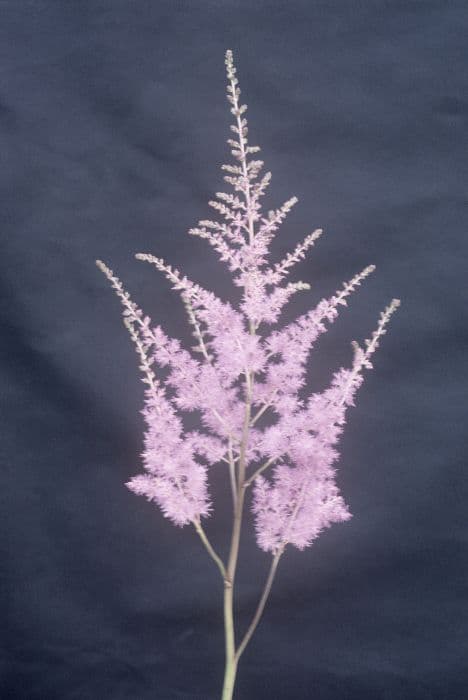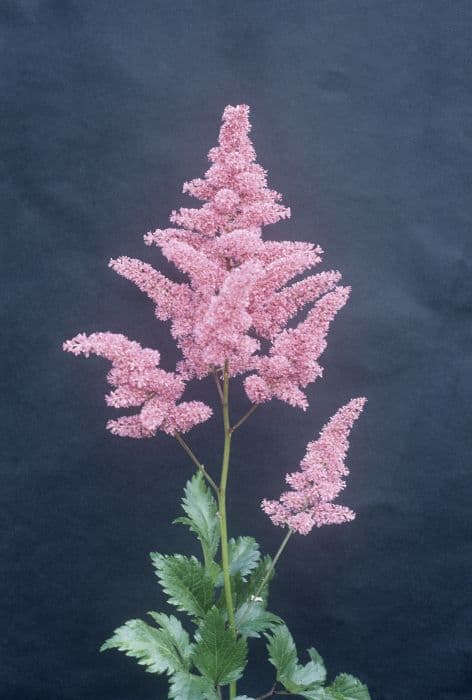Elephant's Ears Bergenia 'Eden's Magic Giant'

ABOUT
Bergenia 'Eden's Magic Giant' boasts large, glossy, rounded leaves that display a lush, deep green color throughout most of the year. The foliage often takes on a striking reddish-bronze hue during the colder months, offering year-round visual interest. Rising above the attractive foliage are striking flower stalks that bear clusters of bell-shaped flowers, typically found in shades pink to magenta, which add a burst of color to the plant's display in the spring season. The overall presentation of 'Eden's Magic Giant' is one of robust health and vibrant beauty, with its thick, leathery leaves and showy blooms creating a substantial and eye-catching presence in gardens where it is grown.
About this plant
 Names
NamesFamily
Saxifragaceae
Synonyms
Eden's Magic Giant Bergenia, Giant Bergenia
Common names
Bergenia 'Eden's Magic Giant'
 Toxicity
ToxicityTo humans
Bergenia 'Eden's Magic Giant', commonly known as Bergenia, is not widely recognized for having severe toxicity to humans. However, as with many plants, individual sensitivities can vary, so it is still advisable to avoid ingesting any part of the plant. If ingested, mild gastrointestinal upset could potentially occur as a common response to consuming non-edible plant matter.
To pets
Bergenia 'Eden's Magic Giant', commonly known as Bergenia, is not generally considered highly toxic to pets. However, like humans, pets may also have individual sensitivities. Ingesting parts of the plant may lead to mild gastrointestinal upset including symptoms such as vomiting or diarrhea. It's always prudent to prevent pets from consuming plants not meant for their digestion to avoid potential health issues.
 Characteristics
CharacteristicsLife cycle
Perennials
Foliage type
Evergreen
Color of leaves
Green
Flower color
Pink
Height
1-3 feet (0.3-0.9 meters)
Spread
1-2 feet (0.3-0.6 meters)
Plant type
Herb
Hardiness zones
4
Native area
Asia
Benefits
 General Benefits
General Benefits- Attractive Foliage - The large, glossy leaves provide year-round visual interest.
- Spring Blossoms - Produces clusters of pink flowers in spring that enhance garden aesthetics.
- Drought Tolerance - Once established, it can withstand periods of low water, making it suitable for xeriscaping.
- Cold Hardy - Can survive in colder climates, making it a versatile choice for various garden zones.
- Low Maintenance - Requires minimal care once established, making it ideal for gardeners of all experience levels.
- Shade Tolerance - Grows well in shaded areas where other plants might struggle.
- Soil Adaptability - Can thrive in a range of soil types, provided they are well-draining.
- Pest Resistance - Generally resistant to common garden pests, reducing the need for chemical treatments.
- Deer Resistance - Less appealing to deer, which can help protect other garden plants.
- Great Ground Cover - Can be used to cover large areas, reducing weed growth and soil erosion.
 Medical Properties
Medical PropertiesThis plant is not used for medical purposes.
 Air-purifying Qualities
Air-purifying QualitiesThis plant is not specifically known for air purifying qualities.
 Other Uses
Other Uses- Bergenia 'Eden's Magic Giant', commonly known as giant bergenia, can be utilized as a natural dye for fabrics due to the pigments found in its leaves.
- Leaves of the giant bergenia can be pressed and used in botanical art pieces for their large size and interesting texture.
- The large leaves of this plant can serve as impromptu waterproof covers or wraps for small outdoor items because of their leathery nature.
- Gardeners often use the giant bergenia as a living mulch due to its dense foliage, which suppresses weeds and retains soil moisture.
- Giant bergenia's leaves can be used to line hanging baskets, helping to retain soil and moisture while adding an aesthetic touch.
- This plant's robust leaves can be carved into stencils for painting or crafting, making use of their unique shape.
- When dried and flattened, the large leaves of giant bergenia can be incorporated into handmade paper for a natural touch.
- The plant can act as an acoustic barrier when planted densely, helping to reduce noise pollution in garden spaces.
- In frost-prone areas, the dead leaves of giant bergenia can provide natural frost protection for more sensitive plants when layered over them.
- The flower stalks of giant bergenia, which are sturdy and visually appealing, can be used as natural supports for other, more fragile plants in the garden.
Interesting Facts
 Feng Shui
Feng ShuiThe plant Bergenia is not used in Feng Shui practice.
 Zodiac Sign Compitability
Zodiac Sign CompitabilityThe plant Bergenia is not used in astrology practice.
 Plant Symbolism
Plant Symbolism- Endurance: Bergenias, with their robust nature and ability to withstand harsh conditions, often symbolize endurance and resilience. 'Eden's Magic Giant', as a variety, reinforces this idea with its bold presence in the garden.
- Protection: The large, leathery leaves of the Bergenia have been thought to represent protective qualities, offering shelter and safety to smaller creatures in the wild.
- Adaptability: Given the Bergenia’s ability to thrive in a variety of climates and soils, it can also represent adaptability and versatility in overcoming life’s challenges.
- Longevity: Bergenia plants are known for their longevity, as they can live and remain vibrant for many years, symbolizing a life of lasting value and permanence.
 Water
WaterElephant's Ears should be watered thoroughly, allowing the soil to become moist but not soggy. During the growing season, water approximately once a week or enough to ensure the soil doesn't dry out completely. In hotter, drier conditions, increase watering frequency. When temperatures cool and growth slows, reduce watering to every two to three weeks. Always check the top inch of soil for dryness before watering. On average, use about half a gallon of water for a medium-sized plant to ensure even soil moisture.
 Light
LightElephant's Ears prefer partial shade to full sun locations. The ideal spot would provide morning sunlight and afternoon shade to protect the leaves from intense heat. Filtered light under tall trees or a north-facing location with bright, indirect light is also suitable for this plant's growth.
 Temperature
TemperatureElephant's Ears thrive in a temperature range between 60 to 75 degrees Fahrenheit but can tolerate a wider range from 50 to 85 degrees Fahrenheit. Avoid exposing the plant to temperatures below 50 degrees Fahrenheit, which can cause cold damage. The plant's foliage can also suffer in conditions above 85 degrees Fahrenheit if not adequately shaded or hydrated.
 Pruning
PruningPrune Elephant's Ears to remove damaged or yellowing leaves and to maintain shape. Pruning is best done in the spring or early summer when the plant begins active growth. Cut back the foliage to the base of the plant as needed for a tidy appearance. Regular pruning also encourages fresh foliage and can prevent common diseases by improving air circulation.
 Cleaning
CleaningAs needed
 Soil
SoilBergenia 'Eden's Magic Giant', commonly known as Elephant's Ears, thrives best in a soil mix that is organically rich, moist, and well-draining. A mixture of garden soil, compost, and perlite or sand to promote drainage is ideal. The pH should be slightly acidic to neutral, ranging from 5.5 to 7.0, to ensure optimal growth and health.
 Repotting
RepottingElephant's Ears should be repotted every 2 to 3 years or when it becomes root-bound. The best time to repot is in the early spring before the growing season starts, giving the plant time to establish in its new container.
 Humidity & Misting
Humidity & MistingElephant's Ears prefer moderate humidity levels. Aim for a humidity level between 40-60% for optimal growth. This plant is quite adaptable, but consistent humidity contributes to healthier foliage.
 Suitable locations
Suitable locationsIndoor
Keep Elephant's Ears in bright, indirect light indoors.
Outdoor
Plant Elephant's Ears in partial shade and moist soil outside.
Hardiness zone
4-9 USDA
 Life cycle
Life cycleBergenia 'Eden's Magic Giant', commonly known as just Bergenia, starts its life as a seed, which when sown, germinates in spring or early summer. After germination, the seed develops into a seedling with a rosette of leaves at the soil surface. As the plant grows, it enters the vegetative stage, producing more leaves and developing a thick, rhizomatous root system. The Bergenia reaches maturity in a couple of years and enters the flowering stage, producing clusters of flowers atop stout stems, typically in the early spring. Following pollination, the flowers develop into capsules containing numerous small seeds. Once the seeds are dispersed, the plant continues its perennial cycle, with the existing plant initiating new growth each spring while new plants may begin their life cycle from the dispersed seeds.
 Propogation
PropogationPropogation time
Spring-Early Summer
The Bergenia 'Eden's Magic Giant', commonly known as the Bergenia, is typically propagated by division. The best time to propagate Bergenia by division is during the early spring months or in the fall after the plant has flowered and as it enters its dormancy period. The chosen period ensures minimal stress on the plant, facilitating better root establishment in the progeny. To propagate by division, carefully dig up the entire plant, making sure to keep the root ball intact. Using a sharp knife or spade, divide the clump into smaller sections, each with several growth buds and a portion of the root system. Replant the new divisions at the same depth they were originally growing, spacing them about 12 inches (approximately 30 centimeters) apart to allow room for their spread. Water the newly planted divisions thoroughly to settle the soil around the roots and to help reduce transplant shock.









